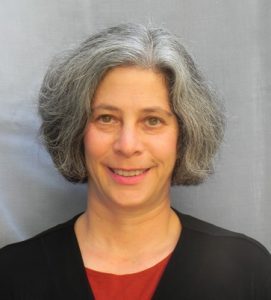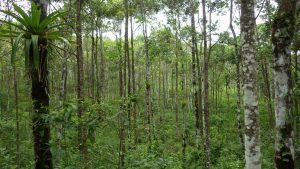
 INTERVIEW with keynote speaker Dr. Robin Chazdon,
INTERVIEW with keynote speaker Dr. Robin Chazdon,
University of Connecticut, USA
Keynote Plenary Session 2
Friday, 22 September, 10:30 – 12:00
Rolf Böhme Saal (Konzerthaus Freiburg)
“Restoration Forestry: Challenges and Opportunities for Foresters, Forests, and Landscapes”
By Bob Burt
IUFRO Science Writer
Dr. Robin Chazdon considers herself a “bit of an outsider” in the forestry world.
She suspects that one of the reasons she was selected as a keynote speaker at the IUFRO 125th Anniversary Congress in Freiburg is because she will challenge the “traditional” mode of forestry and forestry thinking. The perspective she brings is more based on forest ecology and restoration, she said.
Dr. Chazdon has spent about 30 years researching tropical forest regeneration on abandoned pastures.
“As traditionally defined by the forest sector, ‘reforestation’ and ‘afforestation’ are usually focused on industrial monoculture plantations, often appropriating land from peasants or other landless people,” Dr. Chazdon said.
That may hold true in some parts of the world and for some parts of the forest industry, but it should be pointed out that in many areas of the world – Europe, as an example – the concept of sustainable forest management is widely adopted and implemented.
Among IUFRO’s 15,000 scientists in almost 700 member organizations in more than 120 countries, the research agenda is very broad ranging from ecological issues – biodiversity conservation and ecosystem services, etc. – to socio-economic issues such as forest products, rural livelihoods, traditional forest knowledge and the rights of indigenous peoples. Over the past two decades the social sciences, including political science, have been the largest area of growth within the organization.
In her keynote address, entitled “Restoration Forestry: Challenges and Opportunities for Forests, Foresters and Landscapes”, Dr. Chazdon says she will describe ways in which the forestry sector can become more aligned with the broad objectives of landscape restoration, including provision of multiple ecosystem services, protection of biodiversity, and creation of sustainable local livelihoods.
“Realignment of forestry objectives toward landscape restoration,” she said, “will play a key role in achieving global restoration targets, sustainable development goals, and targets of three major international conventions, The United Nations Framework Convention on Climate Change (UNFCC), the UN Convention on Biodiversity (UNCBD) and the UN Convention to Combat Desertification (UNCCD).”

Plantation in Costa Rica composed of multiple native tree species that are common in secondary forests and have wood useful for timber. The plantation also supports diverse plant life forms such as bromeliads and shrubs, which attract wildlife and seed dispersing animals. Photo by Robin Chazdon
From her perspective, she feels “there is a need today for the forest sector to adopt a broader mission; a shift towards ‘forest landscape restoration,’ which goes beyond planting trees to also improve the functionality, sustainability, and governance of landscapes while also favoring carbon mitigation and adaptation.”
This realignment will also require establishment of joint policies, implementation partnerships, and governance arrangements between forestry, agriculture, energy, and environment sectors within countries, Dr. Chazdon said.
She plans to give examples of ways to align plantation forestry and silviculture toward increasing benefits to local stakeholders and for biodiversity. While some of these changes are happening, they are happening slowly and, she believes, “not at the scale needed to accelerate global restoration and achieve a global impact.”
At the heart of her presentation is the fact that “the life support systems of our planet are being strongly compromised and corrections need to be made,” she said.
“Forestry and forests are not just about timber production. In many areas, particularly in the tropics, there is a missing middle ground between managing forests and creating plantations. That middle ground can be more fully integrated into the forestry agenda to address the large-scale need to restore forests and sustainable livelihoods, halt deforestation, protect biodiversity, and reduce and reverse degradation of forest landscapes,” Dr. Chazdon added.
She hopes that her address will generate support for shifting the vision of forestry towards landscape restoration and towards partnerships with other sectors (agriculture, conservation, water resources, mining).
“What I am presenting is not totally new. There was a 2002 report by the International Tropical Timber Organization on this subject that was widely read. But the problem is still with us today,” she added.
“I am not trying to alienate anyone. I will present a compelling argument for my thesis. If people want to disagree, that is their right and they are welcome to do so. Certainly, the economics and institutional aspects of this broadening of vision that I mention need to be much better understood. So, I am presenting this as more of a challenge than as a plan,” Dr. Chazdon said.
“But,” she added, “I do hope to motivate forestry professionals to take action!”
While Dr. Chazdon may consider herself an outsider, in addition to an impressive academic resumé – some 27 years as a lecturer and professor at the University of Connecticut in the Department of Ecology and Evolutionary Biology; current and-or recent academic affiliation with universities in Australia, Denmark, the USA, and Brazil – she also brings to the table some 30 years of research on tropical forest regeneration on abandoned pastures.
Among the titles she holds are: Senior Research Associate with the International Institute for Sustainability in Rio de Janeiro, Brazil; Executive Director of the Association for Tropical Biology and Conservation; Director, People and Reforestation in the Tropics Research Coordination Network (PARTNERS) and Senior Fellow with the World Resources Institute. She has published over 130 peer-reviewed papers. Her book “Second growth: The promise of tropical forest regeneration in an age of deforestation” was published in 2014.
This year, in addition to her speaking engagement with IUFRO, she has also been invited as a keynote or plenary speaker at events in the UK, the USA, Colombia and Brazil.
Come to the keynote plenary session http://iufro2017.com/scientific-sessions/
or follow it on live stream http://iufro2017.com/livestream/
IUFRO 125th Anniversary Congress – Interconnecting Forests, Science and People
The September 18-22 Congress in Freiburg will celebrate IUFRO’s 125th anniversary. Founded in 1892 in Eberswalde Germany, IUFRO has grown to unite more than 15,000 scientists (who cooperate in IUFRO on a voluntary basis) in almost 700 member organizations in more than 120 countries.
http://iufro2017.com/
IUFRO promotes global cooperation in forest-related research and enhances the understanding of the ecological, economic and social aspects of forests and trees. It disseminates scientific knowledge to stakeholders and decision-makers and contributes to forest policy and on-the-ground forest management.
http://www.iufro.org/

Leave a Reply